Understanding Rubellite Pricing: Key Factors and Trends
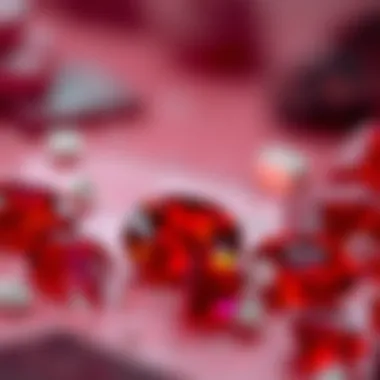
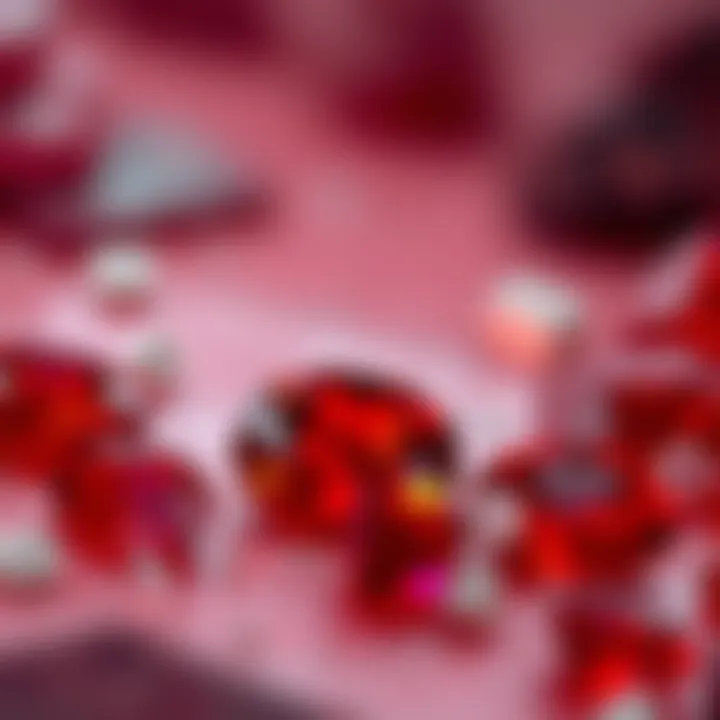
Intro
In the dynamic world of gemstones, rubellite stands out with its vivid colors ranging from bright pink to deep red, captivating both casual admirers and serious collectors alike. Like a dance of light, rubellite's color can shift based on the light source, adding layers of complexity to its allure. This unique character is not just a pretty face; it influences how prices are formed in the marketplace. In this article, we will peel back the layers of rubellite pricing, exploring underlying factors that contribute to its value and how it sits within the broader tourmaline family.
History and Origins
Overview of Collectibles, Rocks, and Fossils
When diving into the narrative of rubellite, one must acknowledge that gemstones are more than just numbers on a price tag; they carry stories, histories, and deep-rooted cultural ties. Rubellite, a pink to red variety of tourmaline, has a rich history, often associated with passion and love. Although not as ancient as some gemstones, rubellite emerged in the late 19th century and surged in popularity due to its striking colors. Collectors appreciate not only the gem's aesthetic appeal but also its ability to evoke emotion and carry a certain mystique over the years.
Many collectors today view stones like rubellite as an investment, much as one would with art or collectible coins. With advances in mining technology and an increased appetite for unique stones, rubellite has found its footing in various markets.
Historical Significance and Cultural Impact
Historically, rubellite's vibrant hues have made it a favored gem among jewelry makers, often featured in ornate pieces designed to symbolize love and affection. From ancient cultures that believed in the mystical properties of gemstones to modern-day collectors who see rubellite as a valuable asset, it holds a significant place in the annals of gem history. For example, in ancient civilizations, the captivating colors were said to represent the sun and were believed to bring happiness and prosperity. Rubellite not only became a fashion statement but also a cultural emblem, entwined in rituals and beliefs.
Identification and Classification
Guide to Identifying Rubellite
Understanding rubellite goes beyond appreciating its beauty; it's essential to recognize how it stands apart from its cousins in the tourmaline family. To help in this pursuit, here is a concise guide:
- Color: True rubellite varies from pink to red, but the most prized stones lean toward a deeper red. Observe the saturation and tone.
- Clarity: High-quality rubellite possesses minimal inclusions. A clear stone resonates significantly in terms of value.
- Cut: A well-cut rubellite maximizes its brilliance. The cut influences how light plays within the stone.
- Carat Weight: Size always plays a role in pricing, with larger stones typically commanding higher prices, barring other quality issues.
Common Types and Variations
Rubellite can also be classified into several categories based on a few characteristics:
- Pink Rubellite: Lighter in hue and often more accessible in terms of price.
- Red Rubellite: The most sought after due to its depth of color. These command premium prices in markets.
- Rubellite with Indicolite: A rare combination where rubellite is paired with the blue variety of tourmaline, creating a striking and uncommon visual.
Preamble to Rubellite
The realm of gemstones is lush with beauty, but the rubellite, a striking member of the tourmaline family, stands out with its vibrant hues and complex pricing dynamics. To appreciate this gemstone fully, one must delve into what makes rubellite both precious and sought after. Understanding the nuances of this stone serves a dual purpose for collectors and enthusiasts. Not only does it provide insight into the considerations of value, but it also fosters a deeper appreciation for the artistry involved in its creation.
Rubellite is more than just another pretty stone. Its rich colors, ranging from deep reds to pinks, reflect an intricate interplay of nature’s forces, including geological conditions and the mineral content that shapes its characteristics. Thus, exploring rubellite helps us understand the broader context of gemstones in the market.
Defining Rubellite
Rubellite is a term that refers specifically to a red to pink variety of tourmaline. Its colors are largely due to the presence of lithium and, in some instances, manganese. Unlike most of its counterparts, rubellite can evoke different shades based on lighting conditions and its particular stone formation. For instance, in daylight, one might notice a brighter hue, while indoors, it may take on a darker tone.
What sets rubellite apart is not just its color but also its clarity. Higher clarity often translates to higher value, with collectors keenly aware of the implications of inclusions on a stone’s worth. To add layers to this definition, rubellite is sometimes mistaken for other red stones, such as garnet or spinel. A collector should properly recognize these distinctions to avoid falling into the common traps that can lead to purchasing missteps.
Geological Formation of Rubellite
The journey of rubellite begins deep within the Earth, where exceptional geological conditions converge to create the right environment for this beautiful stone. Rubellite is primarily found in granite pegmatites, which are formations rich in minerals, formed as magma slowly cools beneath the Earth's surface.
Through the years, mineral deposits have been discovered across various regions, most notably in Brazil, Africa, and the United States.Each locality offers its unique twist on the stone, influenced by the surrounding environment and mineral mixture. For instance, those from Brazil tend to resonate with a richer hue compared to some African sources, which might present with remarkable clarity but less saturated colors. This geographical diversity enhances rubellite's allure but also complicates its pricing structure further.
Moreover, the geological processes affecting these stones contribute to differences in their physical attributes, including hardness and durability. These factors directly impact market demand and, subsequently, pricing. Collectors must take into account these variables when evaluating potential additions to their collections.
As we explore the subsequent sections, we will uncover the critical influences on rubellite pricing, enhancing our understanding of this fascinating gemstone and its place in today's market.
Historical Context of Rubellite
Understanding the historical context of rubellite enriches our appreciation for this captivating gemstone. From its inception in the gem trade to its cultural significance, rubellite’s journey is punctuated by moments that have shaped its valuation and desirability. Recognizing these dynamics can enhance one’s perspective when considering rubellite for personal collections or investments.
Origins of Rubellite in the Gem Trade
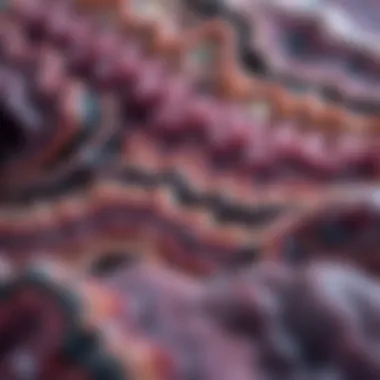
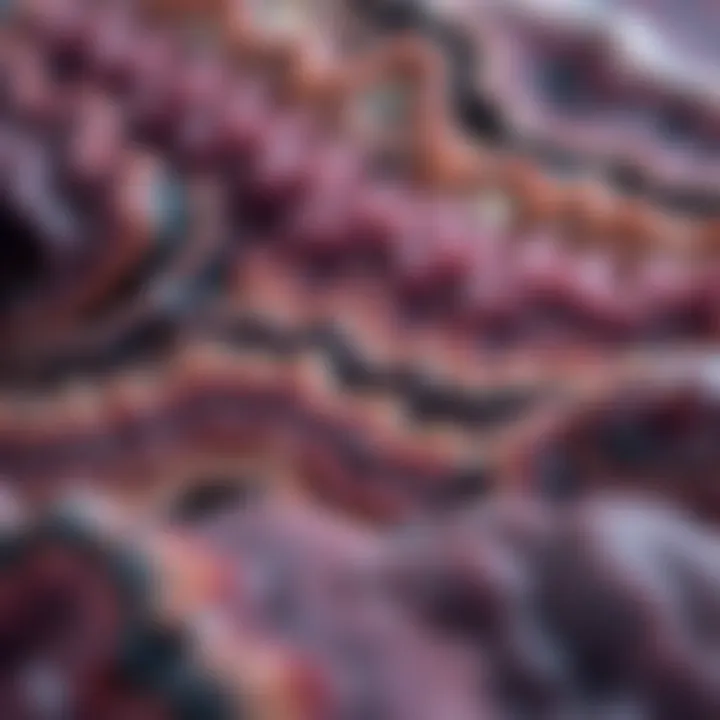
Rubellite, a vibrant pink to red variety of tourmaline, first caught the eyes of gem enthusiasts in the late 19th century. While tourmalines were known for their wide color spectrum, rubellite stood out for its striking hues, leading to its classification as a separate entity within the tourmaline family. The term "rubellite" is derived from the Latin word "rubellus," meaning reddish or red, aptly describing its most sought-after colors.
In 1876, rubellite was first identified in the gem markets of the U.S. and soon became popular among jewelers and collectors. Its deep, alluring colors drew comparisons to rare gemstones like rubies, paving the way for a market eager to explore its captivating beauty.
Throughout the 20th century, rubellite has glided between styles and trends in the jewelry world. Market reports from the 1980s highlight how rubellite's charm was often overshadowed by other, more mainstream gems. However, as consumers sought unique alternatives to traditional gemstones, rubellite began to reclaim its place as a coveted gemstone, especially in handcrafted and artisanal jewelry.
"Rubellite isn’t just a color; it's a conversation starter that transcends its physical beauty."
Cultural Significance Throughout History
Rubellite is more than just a gem; its history is intertwined with various cultures, weaving a tale of significance and value beyond the mere glisten of its surface. In ancient civilizations, particularly in Africa and South America, tourmaline, including rubellite, was believed to hold mystical properties, serving as a protective charm against negativity and harm. The vibrant colors were often associated with life and vitality, fostering a deep connection to the earth.
In modern times, rubellite has also found its place in art and literature. Whether featured in poetry or paintings, this gemstone has inspired many creatives yearning to capture its essence. For instance, in the world of gemstones, the different shades of rubellite are often used to symbolize love and passion, making it a favorite choice for engagement rings and anniversary gifts. People often refer to it in the context of relationships, echoing its emotional undertones.
The cultural narrative surrounding rubellite has grown, too, with contemporary artisans often drawing inspiration from its lore, embedding it in bracelets or pendants that represent personal stories or journeys.
Through these various lenses—historical, commercial, and cultural—the significance of rubellite within the gemstone market and beyond continues to evolve. The interplay of tradition and modernity makes rubellite a gem that not only holds value but also a rich tapestry of meanings, inviting collectors to engage with it on multiple levels.
Factors Influencing Rubellite Pricing
Understanding the nuances of rubellite pricing is vital for both collectors and enthusiasts alike. Several factors contribute to how this gemstone is valued in the market. From vivid colors to the intricacies of cut and clarity, each element plays a critical role in the overall pricing structure. A comprehensive grasp of these factors enhances one’s ability to make informed decisions, whether it be for purchasing, selling, or collecting.
Color Quality and Its Impact on Value
Understanding Color Grades
Color is one of the most significant aspects when determining the value of rubellite. The various shades of red and pink can dramatically alter the price. In the gem world, grades are often assigned, distinguishing between lighter hues, which command less attention, and the fiery reds that capture hearts. Collecting rubellite isn't just about owning a pretty piece; it's about value appreciation. The rich coloration, typically derived from manganese, often sets the benchmark for pricing and desirability. Therefore, understanding color grades allows collectors to recognize true beauty and potential investment value.
Furthermore, the difference between natural colors and those seen in enhanced stones can lead to significant price discrepancies. A well-colored stone fetches a higher price, so having a keen eye for quality is beneficial here. Each grade tells a story about the gem's origins and potential, which makes this aspect integral to pricing discussions.
Preference for Vivid vs. Muted Shades
The preference for vivid shades versus muted ones also weaves its way into the fabric of rubellite pricing. The market often leans towards vibrant, saturated colors that shine with intensity. These vivid stones not only look striking but also captivate the collectors' interest, making them a popular choice. In contrast, muted shades might appeal to some but generally do not hold the same value.
The unique quality of vibrant pigments plays a key role in the emotional connection a buyer has with the gemstone. The brilliance and life that a vivid rubellite exudes can lead to higher prices, while a muted shade may linger on the market longer, creating an uneasiness for sellers. Emotional appeal, it seems, is just as crucial as the physical qualities of a stone.
Cut and Clarity: Their Role in Valuation
The Importance of Cut
Cutting a gemstone is akin to an artist painting a masterpiece; it can make or break its value. A well-executed cut enhances the stone's natural color and brilliance, influencing how light interacts with the rubellite. The beauty created through expert craftsmanship cannot be underestimated. Collectors should prioritize well-cut stones over those with better colors but poor cuts, as the difference in price can be exaggerated. A poor cut might lead to a dismal reflection of the stone’s intrinsic qualities.
Reflections and scintillation of a well-cut rubellite can cause a gem to sparkle like no other. Each facet can tell the story of the stone, leading to a more satisfying viewing experience. In terms of valuation, it becomes clear that the importance of cut is profound; the impression it leaves can sway the buyer's perception, leading to higher or lower pricing.
Evaluating Clarity Levels
Clarity levels also play into how a rubellite is priced. The fewer inclusions a stone has, the higher its value is likely to be. Evaluating clarity levels requires experience but becomes essential for understanding potential pricing. A clear stone allows light to traverse through it unimpeded, creating that breathtaking sparkle that enthusiasts relish.
So, when investigating a potential rubellite, make sure to look closely. Identify inclusions, check for surface blemishes, and assess overall transparency. Each clarity grade can open the door to various pricing structures, influencing how a collector perceives what they need to pay for a coveted piece.
Carat Weight Considerations
While color, cut, and clarity receive focus, carat weight remains a fundamental element in the valuation of rubellite. Simply put, larger stones typically command higher prices, assuming other factors remain constant. This scaling principle applies somewhat universally across gemstones but holds particular weight in rubellite pricing. The difference between a five-carat rubellite and one weighing just two carats not only reflects size but also the rarity of the heavier gem.
However, it's vital to understand that size alone does not denote value. Combining carat weight with other aspects like color and clarity creates a more holistic view of the gemstone's worth. Let’s not forget that sometimes, smaller, high-quality stones can shine just as bright as their larger counterparts, making them equally appealing to collectors who appreciate quality over quantity.
Current Market Trends
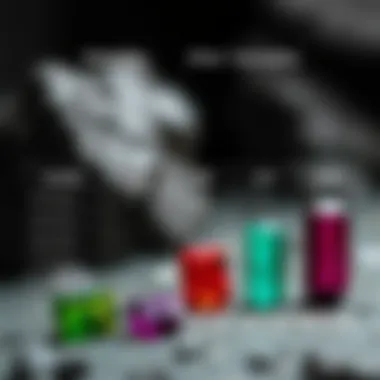
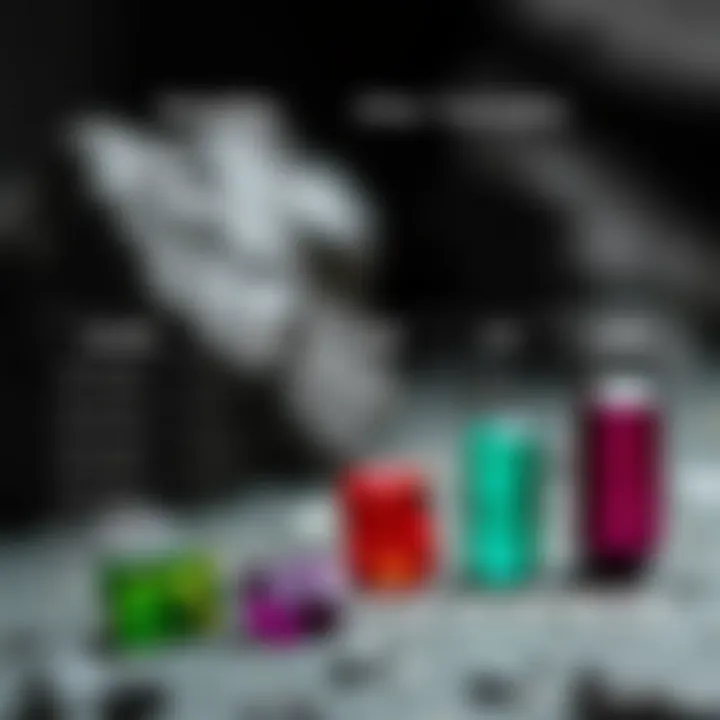
In the world of gemstones, current market trends are akin to the winds that shift a ship's sails. For rubellite, a variety of tourmaline known for its striking pink to red hues, understanding these trends is essential for collectors, enthusiasts, and investors alike. Various factors come into play, from global economic conditions to emerging markets, each with its own set of nuances that affect pricing.
Analysis of Recent Sales Data
The sales data for rubellite offers a revealing lens through which one can view its market performance. Recent auction results have indicated a growing interest in high-quality rubellite stones, particularly those exhibiting vibrant color and clarity. For instance, a remarkable rubellite gemstone sold at a Sotheby’s auction last year fetched nearly triple its estimated price, suggesting that the demand for exceptional pieces is on an upward trajectory.
These patterns in sales can be influenced by several factors:
- Rarity of Color: Rubellites that possess a deeper, more saturated pink or red are more sought after. This rarity directly correlates with increased bidding activity at auctions.
- Market Stability: The prices for rubellite gems appear to be more resilient compared to some other gemstones during economic fluctuations. As collectors look to diversify their portfolios, rubellite presents itself as a favorable option.
- Online Platforms: The rise of online marketplaces has also reshaped how rubellites are bought and sold. Platforms such as Etsy and specialized auction websites have seen a spike in engagement, showcasing a range of rubellite stones and allowing wider accessibility to potential buyers.
"Strong auction results in the past few years show growing confidence in rubellite among seasoned collectors and new investors alike. That sounds like a solid alignment between rarity and demand."
Emerging Markets and Their Influence
The landscape for rubellite pricing is not only shaped by established markets but also significantly influenced by emerging markets. Countries like China and India have witnessed a surge in gemstone appreciation in recent years. As economic prosperity grows in these regions, so does the appetite for luxury items, including gemstones. Rubellite, with its vivid colors and cultural significance, is becoming increasingly popular among collectors in these markets.
Several factors characterize this shift:
- Cultural Appeal: Many Asian cultures place high value on gemstones, associating them with prosperity and well-being. This cultural attachment propels interest in acquiring rubellite and elevates its perceived worth.
- Artisanal Crafting: Emerging markets are also seeing an increase in locally crafted gemstones, aligning with the trend towards unique and ethically sourced pieces. Such local craftsmanship often enhances the value of rubellite within these markets, as consumers seek authenticity.
- Investment Potential: As more investors recognize the potential for gems to appreciate in value over time, rubellite is increasingly viewed as both a collectible and an investment opportunity.
In summary, current market trends paint a vibrant picture for rubellite, marked by strong sales performances and expanding interest from emerging markets. Understanding these dynamics is crucial for anyone looking to navigate the complex world of rubellite pricing.
Comparative Analysis with Other Gemstones
Understanding the comparative analysis of rubellite with other gemstones is pivotal for collectors and enthusiasts who wish to gauge its market value accurately. This comparison provides deeper insights into the unique characteristics and value propositions of rubellite against its counterparts. By examining these differences, one can better appreciate what sets rubellite apart and what influences its desirability in the gem market.
Rubellite vs. Other Tourmalines
Identifying Distinct Characteristics
When we talk about distinctive features of rubellite compared to other tourmalines, the striking color emerges as a key aspect. Rubellite often showcases a wide spectrum of reds and pinkish hues that can bring a striking energy to any collection. This range, rooted in its chemical composition and geological formation, provides gem lovers with a variety of options to choose from. Notably, the vivid tone of rubellite can be more intense than other tourmalines, making it a sought-after gem for vibrancy.
One unique feature worth noting is its ability to show pleochroism. Under different lighting conditions, rubellite's colors can shift, revealing layers and depths not commonly seen in other tourmalines. This quality does not just boost its aesthetic appeal, but it also enriches its narrative, drawing collectors who appreciate the complexity of natural wonders. However, rubellite can sometimes come with inclusions that might be less noticeable in its counterparts, which could affect its clarity grade in the eyes of buyers and appraisers alike.
Market Perception Differences
Examining market perception highlights how rubellite fares against other tourmaline varieties. While many tourmalines are often seen as affordable and accessible, rubellite usually commands a higher price tag because of its rarity and the demand stemming from its captivating colors. A key characteristic here is the overall visual impact. Consumers often perceive rubellite as more luxurious, adding to its appeal in high-end markets.
However, this elevated status comes with its own issues. For instance, the market for rubellite can be trickier as its value largely depends on several subjective factors - not just its physical properties. Collectors often find themselves weighing emotional connections and perceived status rather than strictly adhering to quality metrics. This creates a complex purchasing landscape where enthusiasm and passion might sway decisions more than rational evaluations.
Rubellite vs. Spinel and Other Reds
When placing rubellite alongside spinel and other red gemstones, the dialogue shifts to various perceptions of allure and investment. Rubellite's energetic red hues offer a warm richness, while spinel often brings in a cooler, crisp brilliance. It’s essential to emphasize these subtleties during assessments. Both stones have their own loyal demographics, with spinels appreciated for their clarity and durability, but rubellite retains a place of esteem due to its historical context and cultural gravitas.
The valuation differences between these two can result from practical aspects like availability and market demand. Spinel may sometimes be considered undervalued, yet it challenges rubellite in clarity and resilience. A knowledgeable collector will weigh these distinctions carefully, tailoring selections based on both aesthetic preferences and long-term investment considerations.
Sourcing and Ethical Considerations
The topic of sourcing and ethical considerations in rubellite gemstones is crucial. Not only does the source of a gemstone influence its overall market value, but ethical practices in mining also resonate deeply with today’s conscious consumers. Increasingly, collectors and gem enthusiasts are considering the provenance of their rubellites, adding another layer of complexity to the pricing structure. Thus, understanding where and how rubelite is sourced, along with the ethical implications involved, directly shapes its desirability and value in the marketplace.
Global Sources of Rubellite
Rubellite is primarily extracted from several key locations around the world. These include Brazil, Afghanistan, and Mozambique, each producing distinct variations of the stone. To put it bluntly, the geographic locale can determine not just the color but also the clarity and overall quality of the rubellite.
- Brazil: Known for some of the most vivid rubellites, Brazilian stones often possess a translucent quality that many collectors cherish.
- Afghanistan: While smaller in volume, rubellites from Afghanistan can deliver deep reds typically sought after by serious buyers.
- Mozambique: Recently emerging as a significant player, Mozambique's rubellites are known for their lush pink hues, captivating many in the gemstone community.
Each of these regions carries unique geological characteristics that affect production, but they also come with their own challenges regarding sustainability and ethical mining practices.


Ethical Mining Practices
The ethical considerations surrounding rubellite extraction are more than just a passing thought; they impact everything from the health of the miners to the environmental footprint left by mining operations. Ethical mining encompasses a variety of practices that ensure fair treatment of workers, preservation of local communities, and minimization of environmental damage. Here are some critical aspects of ethical mining in rubellite sourcing:
- Fair Labor Practices: Miners in ethical operations should receive fair wages and work under safe conditions. This is vital as the realities of gemstone mining can sometimes lead to exploitation.
- Environmental Responsibility: Ethical mining practices must prioritize reducing the ecological impact of extraction. This means minimal disruption to the land and restoration of the site once mining is complete.
- Transparency: Consumers are increasingly seeking transparency in their purchases. Sellers who openly share information about where and how their gemstones are sourced tend to foster trust in their clientele.
"Understanding the mining practices behind rubellite can not only inform better buying decisions but also encourage the larger gemstone market to improve workers' rights and environmental standards."
As collectors grow more discerning in their choices, the push for ethically sourced rubellite may redefine market dynamics, potentially elevating prices for those that can show they come from responsible sources. This trend provides an opportunity for collectors to embrace their moral pillar while still indulging in their passion for beautiful gemstones.
Practical Insights for Collectors
For those who have a vested interest in rubellite, this section offers invaluable insights. The price of these gemstones is influenced by various factors, and understanding them can significantly benefit collectors. The gem trade is not just about glitter; it involves a keen awareness of quality, market trends, and even ethical considerations that play into sourcing.
Evaluating Rubellite for Purchase
When it comes to purchasing rubellite, knowing how to assess its quality is paramount. Evaluating these gemstones properly can mean the difference between a wise investment and a costly mistake.
Tips for Assessing Quality
One important aspect of assessing rubellite quality is the stone's color. Multiple shades exist, ranging from soft pinks to vivid reds, and each plays a role in value. The vivid shades tend to command higher prices because they are rarer. A beneficial choice for collectors is to look for stones with a uniform color and good saturation. This quality not only enhances the gem's aesthetic appeal but also its market value.
A unique feature in evaluating rubellite is the concept of color zoning. While some slight zoning can enhance a gem's look, significant variations can detract from its overall value. Therefore, a collector should educate themselves on what to look for. High-quality rubellites are perceived as rare finds, often discovered in specific locations, which can add to their desirability.
Understanding Appraisal Reports
Navigating appraisal reports is essential for a collector wanting clarity on the value of their rubellite. Appraisals should list the gem's characteristics like carat weight, color grade, and clarity. Digging deeper into these reports can provide insights into market trends and help buyers gauge whether they are paying a fair price.
A key characteristic of appraisal reports is their reliance on an established grading system. This can make them a reliable choice for making informed purchasing decisions. However, one must be cautious; not all appraisals are created equal. Some may be based on subjective evaluations rather than established market metrics. Therefore, always seek evaluations from certified gemologists to ensure accuracy.
Displaying and Caring for Rubellite Gemstones
Once you've successfully acquired your rubellite, the next step is ensuring its beauty lasts. Proper display and care are not just practical but necessary for any serious collector. Keep in mind that these gems can be susceptible to scratches and wear, depending on how they are set.
When displaying rubellite, consider lighting. Natural daylight can dramatically enhance their colors without exposing them to harmful UV rays, which may fade the stone over time. Store rubellite in a soft pouch or lined box, separated from other gemstones to avoid scratches.
Additionally, using a mild soapy solution and a soft brush can be effective for cleaning, while avoiding harsh chemicals that might damage the stone.
For more insights, collectors may find useful information on gem care at Gem Society and GIA.
Always remember that your rubellite is not just a purchase; it’s an investment in beauty and history. Proper care ensures its value will persist for years to come.
The End and Future Perspectives
As we draw the curtain on this exploration of rubellite pricing, it’s crucial to recognize the profound nuances surrounding the future of this alluring gemstone. The intricate interplay of various market factors paints a picture that is not merely about oscillating prices but about the broader implications these values have for collectors and the gemstone industry as a whole. Understanding these perspectives can pave the way for more informed decision-making, whether one is engaging in acquisition or merely expanding their knowledge of this beautifully diverse mineral.
The Future of Rubellite Prices in the Market
Looking ahead, the trajectory of rubellite prices is likely to be influenced by several significant elements.
- Market Demand: As the appreciation for unique gemstones continues to grow, rubellite, with its vibrant hues and rarity, stands to gain considerable attention. Factors such as fashion trends or celebrity endorsements can siphon interest towards these stones, potentially pushing the prices skyward.
- Quality Control: The ever-evolving standards of gemstone grading and quality assessments play a critical role in shaping market values. As consumers become more educated and discerning, those rubellites with exceptional clarity and color are likely to command higher prices.
- Supply Struggles: Challenges in sourcing rubellite can also significantly sway its market value. With limited deposits of quality stones being unearthed in recent times, scarcity could fuel a price increase. On the flip side, any discovery of rich deposits could temporarily deflate values.
It's apparent that the rubellite market is akin to a dance of numerous players, each influencing the other in a rhythm of demand and supply.
Encouraging Sustainable Practices in Gem Trading
Sustainability is not merely a buzzword; it’s a necessity in today’s world of gem trading. As collectors and buyers deepen their understanding of rubellite's market, a push towards ethical sourcing is essential.
- Transparency in Sourcing: One of the first steps toward fostering sustainability is ensuring that rubellite and other gemstones are sourced ethically. By tracing the origin of these stones, buyers can support miners and communities engaged in responsible practices, ensuring that profits enhance local economies rather than harm them.
- Advocacy for Fair Trade: Supporting fair trade practices can forge a path toward responsible mining operations. Organizations focused on ethical mining should be recognized and promoted, as they adhere to standards that respect both the environment and labor rights, thereby fostering a healthier industry at large.
"Sustainability in gem trading is not just an ethical obligation, but an investment in the future viability of the industry itself."
- Consumer Responsibility: The role of the consumer extends beyond the purchase. Buyers of rubellite must demand accountability from sellers regarding the origin and mining practices associated with their gemstones. This not only impacts the attributions of the stones but contributes to a broader cultural shift in the trading of gems.



